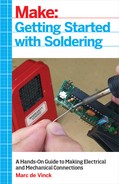Preface
My adventures in soldering began with a kit that I ordered from a person in Long Island City about 10 years ago. The kit was a mini persistence-of-vision (POV) circuit. It consisted of a series of LEDs that would turn on and off at a very specific rate, and if everything went well, you could wave it in the air to spell out a word or create a graphic. It was magical!
The only problem was it had to be soldered. Although I had soldered before, I had never soldered anything as ambitious as a printed circuit board. I ended up purchasing a very inexpensive soldering iron and somehow managed to solder it together and get it to work. The feeling of accomplishment was amazing, and I was hooked on learning more about soldering electronics.
Learning to solder was a bit intimidating. There were all types of irons and tips, and even different types of solder. Who knew there would be so many different choices?
By the way, that cheap iron I bought for the POV project subsequently caught fire! (Don’t worry! We’ll also talk about how to make sure you choose the right equipment!)
I learned almost everything I know about soldering by getting advice from other Makers, looking up information and videos online, and, most of all, from years of practice and first-hand experience soldering and making electronic kits. Along the way, I designed and helped launch the Learn to Solder program at Maker Faire, which is now sponsored by Google and has taught thousands of young people this valuable skill.
In this book, I will give you helpful advice on navigating the available tools and materials as to what may be your best buying options. I’ll also show the basics of soldering through-hole components, and then later on, more advanced techniques about soldering surface-mount components that are typically reserved for robots and professionals. I hope this book also helps you avoid some common pitfalls, or at least minimize their impact. I’ll show you examples of the typical things that can (and will) go wrong when soldering, and I’ll also show you how to fix them.
In full disclosure, I should mention that many of the products used in this book were generously donated by Adafruit Industries (adafruit.com). I’m grateful for their help. Few companies offer electronics enthusiasts such great products and customer support. If you want to learn more about electronics, you should check out their website—it’s more than just a store. They also have an excellent learning system (learn.adafruit.com). You might even see a few of my projects there!
That said, you do have options when shopping for soldering irons and supplies. Other online sites that cater to electronics hobbyists include Sparkfun (sparkfun.com), Jameco (jameco.com), Digi-Key (digikey.com), and many others in the United States and around the world. You can also typically find a basic soldering iron and related supplies at local hobby shops.
Oh, and as it turns out, that POV kit I mentioned back at the beginning of this preface was created by a woman named Limor Fried. Thanks, Limor, for your continued support and for being the catalyst for my own Making adventures!
